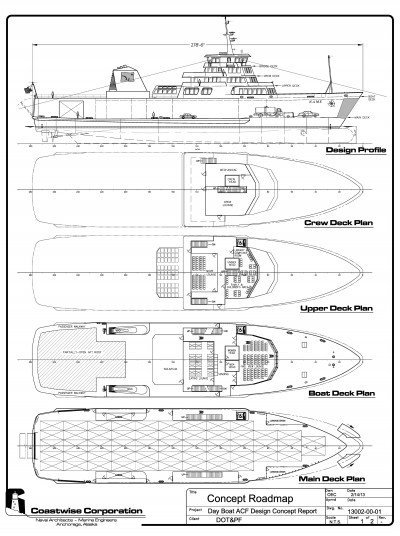Some lawmakers and Marine Transportation Advisory Board members are questioning plans for a pair of shuttle ferries that will provide service in northern Southeast Alaska.
Ferry officials released preliminary descriptions and drawings earlier this week. They described identical, 280-foot, 300-passenger, 53-vehicle day boats that would serve Juneau, Haines and Skagway.
The plan went before a joint meeting of the House and Senate Transportation Committees today.
Juneau Senator Dennis Egan asked Deputy Transportation Commissioner Reuben Yost about two of the most common concerns –harsh storms and a partially open car deck.
“What happens when that ship has to turn around and the spray comes into the open stern? That really worries me,” Egan asked.

“You’re talking about a fairly extreme situation. … The turnaround situations with the LeConte are primarily because of the ice spray freezing on the … lifeboats. They don’t threaten the stability of the ship. They threaten the ability to launch if there is a crisis with the ship for other reasons,” Yost answered.
He told legislators the state expects the ships can be built for the $117 million remaining for design and construction.
Wrangell Representative Peggy Wilson asked whether that included terminal modifications.
“For the adjustments to the harbor itself where they have to make adjustments for the … roll-on, roll-off? Is that included in here?” Wilson asked.
“This is just vessel costs and project development costs. There will be required end berths, probably bow berths, in Haines. We estimate that cost now at $20 million. So that’s an additional cost,” Yost answered.
He said the terminal would be eligible for federal funding. Ship construction will not, because officials plan to give a preference to in-state shipyards.
Several lawmakers questioned the shuttle’s safety and passenger comfort level in rough weather.
Chickaloon Representative Eric Feige said the design could cut down on schedule flexibility.
“This is going to really limit the usage of these ships. So these ships are just going to be Lynn Canal only. You’re not going to be able to divert them if you have a need elsewhere in the fleet?” Feige asked.
“We have shown, at least schedule-wise, that this vessel can go to Hoonah, to Angoon, to Gustavus and to Tenakee. And we’ve shown for extended voyages where we have to fill in in an emergency situation going to Sitka, and then housing the crew overnight on shore. This vessel would be designed for those weather conditions as well,” Yost answered.
Yost and Falvey also presented shuttle plans to the state’s Marine Transportation Advisory Committee.
There was no time for discussion or questions. But afterward, member Mike Korsmo, a Skagway tugboat captain, said he worried about freight capacity.
“They’re saying right in the report that you can’t put a car on and have somebody pick it up on the other end,” Korsmo said. “Well, the freight comes that way to Skagway quite a bit, where a tractor comes down, grabs the container and takes it off. And that’s where most of our store supplies come (from).”
The two-shuttle plan replaces an earlier effort to build a larger ferry with more amenities.
Juneau Chamber of Commerce CEO and advisory board member Cathie Roemmich said that became too big and expensive.
“Now we see something that I believe is within our grasp. And I hope the governor and DOT move forward with it, and we don’t pause or take too much time arguing whether it’s the right thing or the wrong thing,” Roemmich said. “I think these vessels will be a great addition to the Alaska Marine Highway.”
The change in plans, announced late last year, was made without input from the advisory board or lawmakers. That offended many of those involved.
Board Chairman Robert Venables said the panel is now in the loop and will make sure the public has a voice.
“There is going to be a path forward to receive input from outside DOT into the process of building this next generation,” Venables said.
Public testimony is on the agenda for future ferry advisory board and transportation committee meetings.
